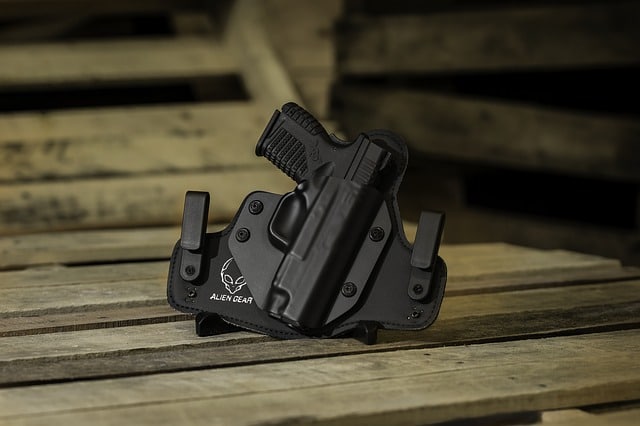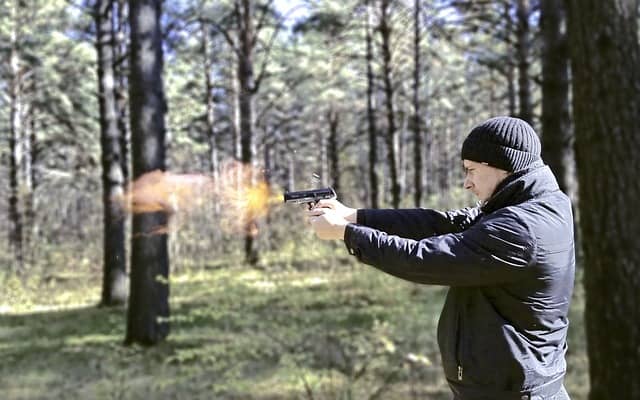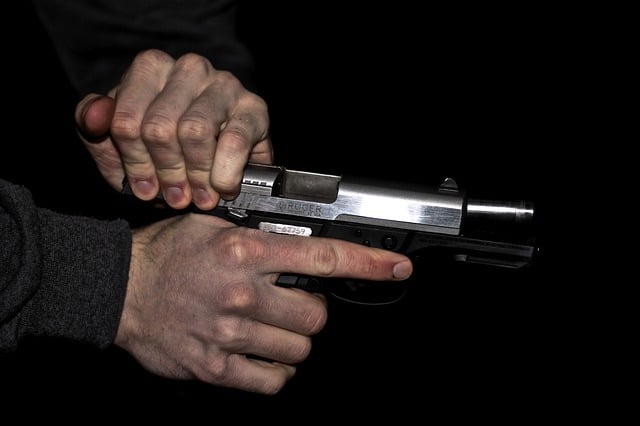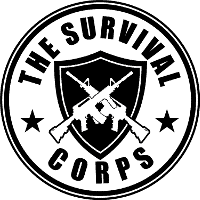Despite some political leaders and people disputing the second amendment, it is no lie that students are at risk of being attacked at any time. Colleges and universities can be prime targets for mass shootings and other terrorist attacks. Furthermore, students can get targeted, assaulted and even murdered. Handgun training is a must!
All these cases call for students to be qualified shooters with the intention of safely taking control of the situation, saving civilians and himself. Also, if you’re a doomsday prepping person, you should start training yourself on how to use prepper handguns. It all starts with training, though, to set you on the path of being a qualified shooter, here are seven tips for learning how to shoot a firearm.
Learn the basics safety principles

Safety is everything when handling any kind of weapon and you should take extra precaution with guns. Remember that as much as the gun has the power to save your life or the lives of others, it can still seriously injure you or worse. Some have had fatal accidents when handling their own firearms, which stresses the importance of being safety conscious when dealing with guns.
Ensure that when you aren’t ready to fire the firearm safety is on and that it is holstered at all times. Only withdraw your pistol when you are ready to fire at some targets that are downrange.
That especially applies when you are at the range and using live ammunition. Extra precautions should be taken in that case. Those safety principles will help you be a better gun owner because you will learn the way you should handle your firearm in public spaces.
When you are at a kill house, learning basic CQB drills involving shooting targets at close range, ensure that you have dummy rounds. If you will clear the kill house with friends or have human role players that are targets, ensure that the handgun is safe to do so. Remove the live ammo from the house and ensure that you only have dummy rounds.
Also Read:A Short Introduction to Firearms From a Survivalist Perspective
Traveling with a handgun
When traveling for hunting or any other purpose as such, you need to know the firearm laws operational in that place to stay out of trouble. Another great idea is to buy the best travel accessories and hunting gear to make the trip more enjoyable. Overall, it’s all about being safe and at your comfortable best.
And when you are traveling, you also need to take care of your business papers, data analysis reports and PPT’s if you are a businessman or an employee with some company. If you are a student, you need to take care of your paper work or to prepare your cover letter. In such a case, you need an expert essay writer or the resume writer. A quick search will simply guide you to the further tools for that:
- Superior papers reviews
- Assignment help UK
- Best essay writing service 2020
- Best resume writing service
- Write my thesis
Getting the proper grip
Gripping is one of the most important parts of shooting because if the grip isn’t right, the gun will start swaying in all different kinds of directions. It goes without saying that when the weapon starts jumping up and down, it is hazardous for you and those nearby.
Generally, a handgun needs both of your hands to grip perfectly and if you are a beginner, it is highly recommended that you do so. The technique to master here is to primarily hold your gun with the dominant hand first and align the trigger finger with the barrel and not on the firing pin.
Afterward, use the other hand to cover the gap on the other side of where you’re holding the gun. Ensure that the hand isn’t underneath the magazine because it serves no purpose there and might throw you off.
The perfect grip is when both the thumbs are aligned on either side of the handgun. Once you have held it correctly, make the grip firmer to have more control of the weapon when firing.
Also Read:Ammo Storage Tips: A Guide to Protecting Your Stockpile
Don’t expect the recoil

The recoil of weapons differs; it is mostly dependent on the caliber of the handgun you are using. There are .38s, .22s, and 9 mm handguns, which are the most popular amongst qualified civilian shooters.
Many have the misconception that the smaller the weapon, the less recoil they will encounter. The truth is you might encounter more recoil from smaller weapons, so it is advisable starting out with medium to larger pistols.
Even when dealing with those kinds of firearms, do not expect the recoil, but rather let is surprise you. That’s where most beginner shooters often go wrong. They expect the recoil to either go up or down and sometimes even sideways. That could lead to you not shooting straight and endangering the lives of nearby civilians if that were a real-life scenario.
When practicing how to shoot, relax and breathe before squeezing the trigger finger. Avoid misaligning the hands but rather point the muzzle right where you want to and don’t move anything but the trigger finger. That will help make communities safer in conjunction with the different self-defense laws in US states nationwide.
Also Read:Improvised Weapons in Home Defense
Perfectly align your trigger finger
The fate of someone’s life may be at just one squeeze of the trigger, which makes it the most important part of any gun. That also makes it important to learn how to shoot straight to avoid any mistakes that could happen. Once you have gripped the gun perfectly and have the target in the sights, you should gently squeeze the trigger.
The trigger shouldn’t be pulled by the tip of the finger or the crease of it, rather the middle of the first part before the first joint. If you fire with that part and not the tip or crease of the finger, the gun won’t sway from left to right.
When squeezing a trigger with a misaligned finger, you will push it to either side, causing the recoil to be magnified in that direction. Therefore, it is very important to concentrate on your finger to have a good trigger control for accuracy.
Don’t keep the finger on the trigger at all times, rather keep it away right alongside the barrel of the gun. If you do so, you’ll avoid accidental discharges of live rounds that could seriously injure or kill someone.
To prepare for hunting season, professional hunters practice firing their weapons, including the way to handle the trigger finger. It requires constant practice for it to become second nature to, but in due time, it will all come to you.
The stance of shooting a handgun
How you stand also determines the trueness of the shots you’ll fire, if the stance is not correct, you stand a higher chance of missing the target.
What makes this tricky is that there are many stances that you have to master because you should learn how to shoot standing, lying on the belly or kneeling. All these positions have their different stances that will dictate how accurate and efficient the shots you fire are.
The most common factor that these stances have is that you have to extend your arms to the fullest when you are ready to fire. That is the standard for handguns but there are some very unique cases where you might be required to fire with your pistol closer than usual. The greatest benefit of extending your arms to the fullest is that you get to see the target on the sights more effectively.
You should also place the dominant foot a little bit in front of the other, relax the shoulders, breathe and then fire. Even when kneeling, ensure that the shoulders are relaxed and not high up to align with the ears.
Reloading ammunition

Going Winchester on the shooting range can be relatively easier than when you are out on your own. On the shooting range, you probably have someone loading the firearm for you and returning it when it is time to shoot.
While you are out there and an incident comes up, no one will be there to reload the firearm for you. That makes it important to learn about the magazine mechanisms on how to unlock it from the pistol and how to return it.
Also, you should learn how to load the bullet rounds on the magazine quickly and efficiently while mastering the art of inserting it back to the handgun. In this case, speed is very important. Reloading should be done swiftly to allow little to the enemy to make his advances.
Train yourself how to reload after firing the entire magazine and get rid of any nerved by breathing in and out to calm yourself.
When you panic, the magazine or bullets might get misaligned, leading to more time spent trying to rectify that mistake. Remember that when you take more time to reload, that can lead you to death of the injury of people you’re trying to protect.
Holstering the handgun
It has been mentioned above that you should holster the handgun when you aren’t using it, but how is that done? There are different kinds of holsters for various applications.
You can get a regular holster that will attach to the belt you wear and then holster the weapon on the exterior of the clothes you’re wearing. Others, however, prefer concealing their weapon in many different ways.
The most popular concealed carry is the inside waistband on either side of the individual, depending on the dominant hand. Some opt for an inside waistband carry that is at the back while others prefer AIWB.
The Appendix Inside Waistband Carry (AIWB) is one of the best concealed carries because you can easily protect the handgun from people who are trying to disarm you.
It’s also easy to withdraw the pistol but extra caution should be attributed to this concealed carry method because if the safety is not on, nasty mistakes can happen.
There are also holsters that are suitable for shoulder carry, so it is up to you which type of holster you prefer. The most important thing about holstering is that it should be efficient for your shooting. In essence, it should be quick and easy to withdraw the pistol and also easy to holster it back in.
The bottom line
As a student, you shouldn’t completely disregard the subject of using firearms for self-defense. Focus on using this type of weapon safely. Owning a handgun could be very beneficial for you and even save your life. Get a professional to teach you all the intricacies of handling one. If you do so, the safety of those near you will be heightened as you will be able to use a firearm when needed.
